
Phonograph cylinders are the earliest commercial medium for recording and reproducing sound. Commonly known simply as "records" in their heyday, a name which has been passed on to their disc-shaped successor, these hollow cylindrical objects have an audio recording engraved on the outside surface which can be reproduced when they are played on a mechanical cylinder phonograph. The first cylinders were wrapped with tin foil but the improved version made of wax was created a decade later, after which they were commercialized. In the 1910s, the competing disc record system triumphed in the marketplace to become the dominant commercial audio medium.
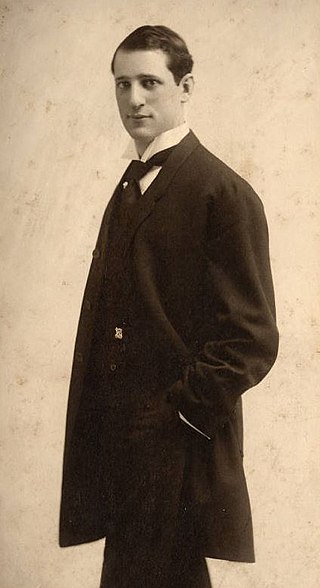
Albert Von Tilzer was an American songwriter, the younger brother of fellow songwriter Harry Von Tilzer. He wrote the music to many hit songs, including, most notably, "Take Me Out to the Ball Game".
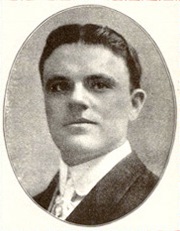
William Thomas Murray was one of the most popular singers in the United States in the early 20th century. While he received star billing in Vaudeville, he was best known for his prolific work in the recording studio, making records for almost every record label of the era. Murray was the best-selling recording artist of the first quarter of the 20th century, selling over 300 million records during the phonograph era.

"The Teddy Bears' Picnic" is a song consisting of a melody written in 1907 by American composer John Walter Bratton, and lyrics added in 1932 by Irish songwriter Jimmy Kennedy. It remains popular in Ireland and the United Kingdom as a children's song, having been recorded by numerous artists over the decades. Kennedy lived at Staplegrove Elm and is buried in Staplegrove Church, in Taunton, Somerset, England. Local folklore has it that the small wooded area between the church and Staplegrove Scout Hut was the inspiration for his lyrics.

Arthur Francis Collins was an American baritone who was one of the pioneer recording artists, regarded in his day as "King of the Ragtime Singers".
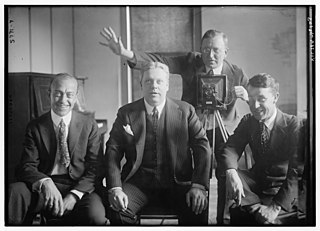
The Peerless Quartet was an American vocal group that recorded in the early years of the twentieth century. They formed to record for Columbia Records, where they were credited as the Columbia Quartet or Columbia Male Quartet. From about 1907, when they began to record for record labels other than Columbia, they were more widely known as the Peerless Quartet.

Ada Jane Jones was an English-American popular singer who made her first recordings in 1893 on Edison cylinders. She is among the earliest female singers to be recorded.

Leonard Garfield Spencer was an American singer, composer, booking agent and vaudeville star who was considered one of the most popular recording artists in the United States from the 1890s to the 1910s.
"Hesitation Blues" is a popular song adapted from a traditional tune. One version was published by Billy Smythe, Scott Middleton, and Art Gillham. Another was published by W.C. Handy as "Hesitating Blues". Because the tune is traditional, many artists have taken credit as writer, frequently adapting the lyrics of one of the two published versions. Adaptations of the lyrics vary widely, though typically the refrain is recognizably consistent. The song is a jug band standard and is also played as blues and sometimes as Western swing. It is cataloged as Roud Folk Song Index No. 11765. Composer William Grant Still arranged a version of the song in 1916 while working with Handy.
The Cylinder Audio Archive is a free digital collection maintained by the University of California, Santa Barbara Library with streaming and downloadable versions of over 10,000 phonograph cylinders manufactured between 1893 and the mid-1920s. The Archive began in November 2003 as the successor of the earlier Cylinder Preservation and Digitization Pilot Project.

Alessandro Bonci was an Italian lyric tenor known internationally for his association with the bel canto repertoire. He sang at many famous theatres, including New York's Metropolitan Opera, Milan's La Scala and London's Royal Opera House, Covent Garden.

William Reese Jones was a tenor who recorded during the 1920s and 1930s, finding fame as a radio star on The Happiness Boys radio program.

The "Black and White Rag" is a 1908 ragtime composition by George Botsford.
"Good Evening, Caroline" is a 1908 popular song, written by Albert Von Tilzer and Jack Norworth. The singer Billy Murray made at least two recordings of the song: one from 1908 on Edison Records, and one in 1909 on Indestructible Record Company. The 1909 recording became one of the most popular recordings of its year. Murray's versions are the most commonly heard today.
I'm Afraid to Come Home in the Dark is popular song, written by Egbert Van Alstyne and Harry Williams in 1907, and made famous by Billy Murray. Today it is popular among collectors of cylinder recordings. Billy Murray recorded the song on several record labels, including Edison Records in 1908. This version is now in the public domain.

"Any Little Girl, That's a Nice Little Girl, Is the Right Little Girl for Me" is a popular song, first published in 1910, and written by Thomas J. Gray and Fred Fisher. Although largely forgotten today, a 1911 recording of the song by Billy Murray on Zon-O-Phone Records survives, and is widely accessible because the recording has entered the public domain. It was also featured in a Max Fleischer "Follow the Bouncing Ball" sing-a-long animated cartoon in the early 1930s. The song appears on the soundtrack of the 1933 film Stage Mother. Subsequently, in 1938 it was recorded for Bluebird Records by Shep Fields and his orchestra, with the accordionist John Serry Sr.

"Will the Circle Be Unbroken?" is a popular Christian hymn written in 1907 by Ada R. Habershon with music by Charles H. Gabriel. The song is often recorded unattributed and, because of its age, has lapsed into the public domain. Most of the chorus appears in the later songs "Can the Circle Be Unbroken" and "Daddy Sang Bass".
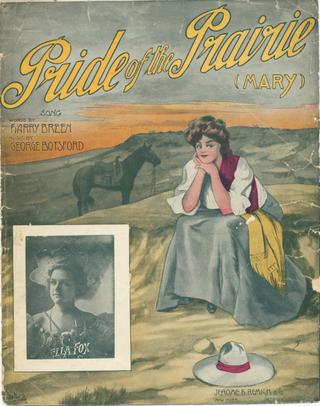
"Pride Of The Prairie" is a popular song written in 1907 with music by George Botsford and lyrics by Henry J. Breen. The lyrics tell of a cowboy's love for Mary, the "Pride of the Prairie".
U.S. Everlasting Records was an American record label which was in operation from 1908 to 1912. It issued two-minute and four-minute phonographic cylinders made of celluloid, and released over 1000 titles.
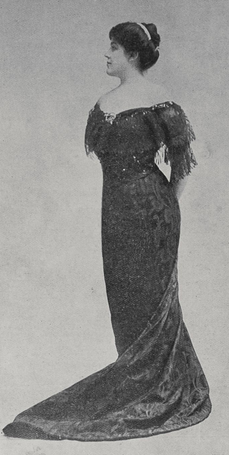
Marie Narelle, born Catherine Mary Ryan, was an Australian singer, billed as "the Australian Queen of Irish Song".














